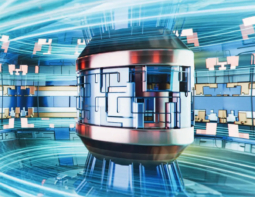
A nuclear clock based on thorium-229 is one step closer now that researchers in Germany and Austria have shown that they can put nuclei of the isotope into a low-lying metastable state.
The exceptionally low 8 eV excitation energy corresponds to light in the vacuum ultraviolet, which can be generated by a laser. As a result, the transition could be used to create an accurate clock. Such a nuclear clock would, in principle, be more stable than existing atomic clocks because it would be much less susceptible to environmental noise. A nuclear clock could also be more practical because unlike an atomic clock, it could be a completely solid-state device.
However, this high accuracy and stability makes it difficult to observe and excite this transition because the light involved has a very narrow bandwidth and can be difficult to find. Indeed, it was only last year that researchers at CERN made the first direct measurement of photons from the transition, whereas the existence of the transition was confirmed in 2016.
Lower-cost laser
Thorium-229 is not the only nuclei that is being explored for use in a nuclear clock. Work on scandium-45 is further advanced, but this nucleus has a transition energy of 12.4 keV. This means that it would have to be paired with an X-ray laser to create a clock – and such lasers are large and expensive.
The new research was done by a collaboration of physicists from the Federal Physical and Technical Institute in Braunschweig, Germany, and the Vienna University of Technology in Austria. One of the team members is Ekkehard Peik, who came up with the idea of a nuclear clock 20 years ago.
Nuclear and atomic clocks work in much the same way. The transition of interest is excited by a laser (or maser) and the emitted light is sent to a feedback control mechanism that locks the frequency of the laser to the frequency of the transition. The extremely stable frequency of the laser light is the output of the clock.
The first clocks (and the current international time standard) use microwaves and caesium atoms, while best clocks today (called optical clocks) use light and atoms including strontium and ytterbium. Optical atomic clocks are so reliable that even after billions of years they would be out by just a few milliseconds.
Smaller is better
A large part of this performance is down to how the atoms are trapped and shielded from electromagnetic noise – which is a significant experimental challenge. In contrast, the nuclei are much smaller than atoms, which means that have much less interaction with electromagnetic noise. Indeed, instead of being isolated in a trap, clock nuclei could be embedded in a solid material. This would greatly simplify clock design.
In their experiment, the Austrian and German physicists doped calcium fluoride crystals with thorium-229 nuclei, which they got from a nuclear disarmament program in the US. The thorium-doped crystals were only a few millimetres across. They then used a tabletop laser to excite the thorium-229 to the desired low-energy nuclear state. This excitation was confirmed using a technique called resonance fluorescence, which involves detecting the photons that are emitted when the excited nuclei decay back to the ground state.

Nuclear clocks: why an experiment at CERN brings them closer to reality
“This research is a very important step in the development of a nuclear clock,” says Piet Van Duppen of KU Leuven in Belgium, who works on nuclear clocks. “It proves that this development is technically possible, also for solid-state clocks. We assumed that laser excitation of the nuclear transition would be detectable in optical traps, but until now there were doubts if this was also the case in solid-state crystals.”
Potential applications for nuclear clocks of the future lie mainly in the detection of tiny time variations that could point to new physics beyond the Standard Model. This could include variations in the fundamental forces and constants. In particular, the clocks could reveal new physics by looking for variations in the nuclear force, which binds nuclei together and ultimately defines the clock frequency. As a result, nuclear clocks could shed light on some of the big mysteries in physics such as the nature of dark matter,
The clocks could also be used to measure time dilation due to differences in the gravitational pull of the Earth. This could be done using miniature and highly mobile nuclear clocks on chips that could be easily moved around to different locations. This would be very useful for doing geodesy and geological studies.
A paper describing the research has been accepted for publication in Physical Review Letters.



